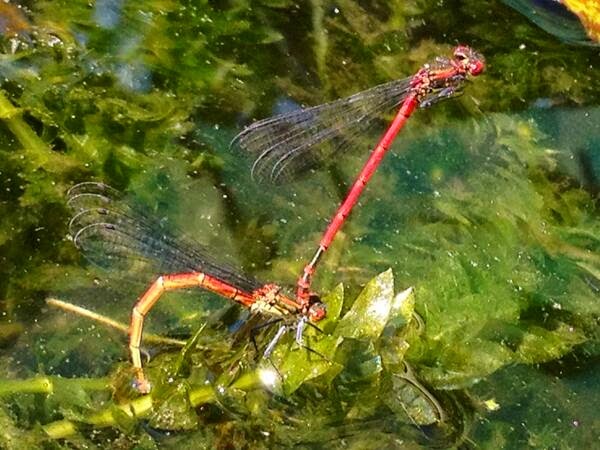Well our Spring Arrivals list is now complete thanks to the last two Garden Warbler and Whitethroat arriving this weekend.
 |
| The list as of 17th April, now completed. |
As you can see, the surprise early visitors were the Blackcap, Hobby and Swift, the last of which turned up this weekend.
 |
| Swifts now flying past visitor centre. |
These arrivals, coupled with a few other arrivals not on the list such as Common Sandpiper seen at Steggall’s this week, bring our bird species list up to an incredible 123 species for 2015.
 |
| Common Sandpiper © Barry Woodhouse |
To see our complete list that is being continually updated as the birds come in, click here. Also, make sure to follow us on Twitter (@SWTLackfordLake) and also on Facebook. Any new sightings we have, we will post them here too.
Of course, it’s not just about the birds, there’s the other wildlife that visits and lives on the reserve and one of these was spotted the other week by one of our volunteers Sally Wooldgridge.
 |
| Grass snake © Sally Wooldridge |
Butterflies have also been in abundance and with temperatures set to rise in the upcoming weeks, their number are sure to increase too. One little beauty that’s been spotted several times this week is the aptly named Orange-tip butterfly.
 |
| A male Orange-tip feeding (nectaring). |
It is only the male that has the Orange tips to the wings, the female has black tips. Ye both sexes have a mottled green and white underwing with gives them incredible camouflage when they sit with their wings tightly closed.
There be dragons!
Other insects that you should be on the look out for are of the family Odonata, which everyone else will know as Damselflies and Dragonflies. Lackford has a special SSSI (Site of Special Scientific Interest) designation for its 17 species of dragonfly and now is the time that they start emerging from the depths of Lackford’s lakes where they’ve spent the last 3-5 years feeding as an aquatic invert and fish and other insects. As the temperature rises, the water gets warmer and this triggers something in the larvae, which makes them begin to climb out of the water via a reed stem. Once out of the water, the next stage commences where the larvae, which sheds its skin as it grows, will shed its skin for the last time and will emerge as an adult dragonfly (or damselfly). It will pump up its wings unfurling them as it does so and after a brief period of drying out in the rays of the sun, the dragonfly will take to the air as a supreme aerial insect hunter.
 |
| Four-spotted Chaser dragonfly |
The diet of a dragonfly is huge, so huge that 75% of it’s adult life is spent eating. Someone once said that “if Dragonflies ate Gazelles, Lions would go hungry.”
One of the first to emerge will be the Large Red Damselfly. Damselflies can be distinguished from Dragonflies by two simple observations. First the wings. Most Damselflies hold their wings back in line with their bodies when sitting at rest, Dragonflies hold their’s out 90º away from the body. The second thing to look at is the abdomen. On Damselflies, the abdomen is long and thin, Dragonflies vary in length, but for the most part, their abdomens are much thicker. there is one more observation, but you have to get a bit closer to see it and it’s all about the eyes. Damselflies eyes are set apart from each other, whereas Dragonflies eyes meet in the middle and are relatively huge for their head.
 |
| A pair of mating Large Red Damselflies. |
If you want to come to Lackford to see some wildlife, don’t forget that we have a large range of FSC guides in the shop to help you identify the things you see and it’s always worth chatting to the staff to find out what is happening where.
Sightings
At last, the elusive Kingfisher has been spotted and is showing well at the false bank at Hawker Pool. It is believed that they may nesting there and feeding their young, so this is a good place to try on a regular basis if you want to see Kingfishers. However, as always, it’s best to ask in the centre first to save a wasted journey. Common Sandpiper as mentioned above has been spotted from Steggall’s along with Lapwing, Egyptian goose and Tufted Duck. Red Crested Pochard can still be seen from The Fuller Mill hide and Great Crested Grebes are nesting near Bess’ hide giving everyone a good show.
Little Ringed Plover, Redshank and Oystercatcher to name a few, are being spotted on the Slough. Willow warbler and Nightingales are still being seen and heard from around the car park outside the visitor centre and Blackcap and Chiffchaff can be spotted all around the reserve.
 |
| Willow Warbler in fine tune © Barry Woodhouse |
The Spring Arrival list may be full, but there’s still more to come and over the next few weeks as more and more birds arrive, the reserve should become full of the sounds of birds singing and calling. One of these special ones to listen out for in the coming weeks is Turtle Dove, if we’re lucky. These birds are having a very hard time of late with over hunting in Europe and loss of habitat. If you think you’ve heard or seen one on the reserve, then please share your sighting with the staff in the centre so that we can share it with others, thanks.
No comments:
Post a Comment